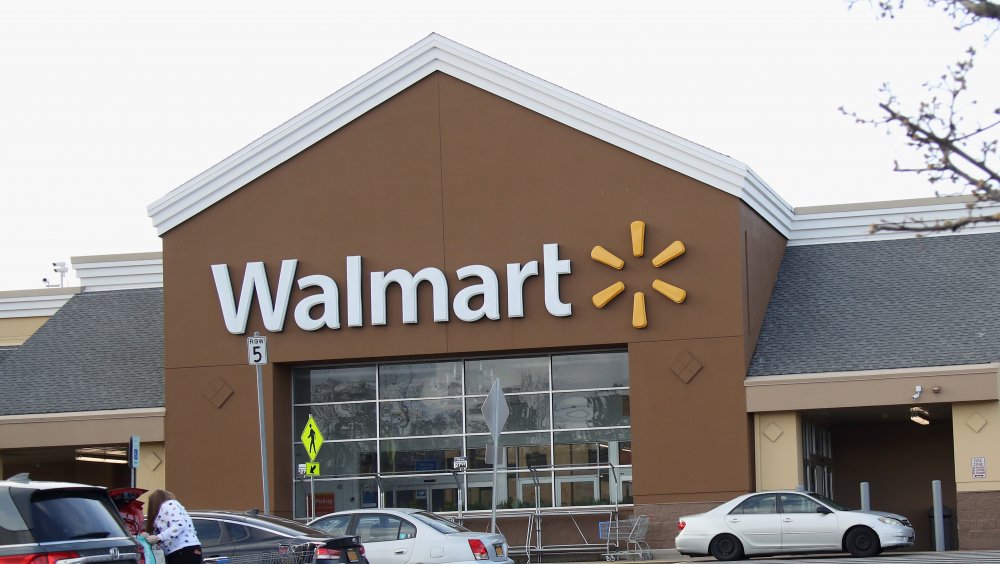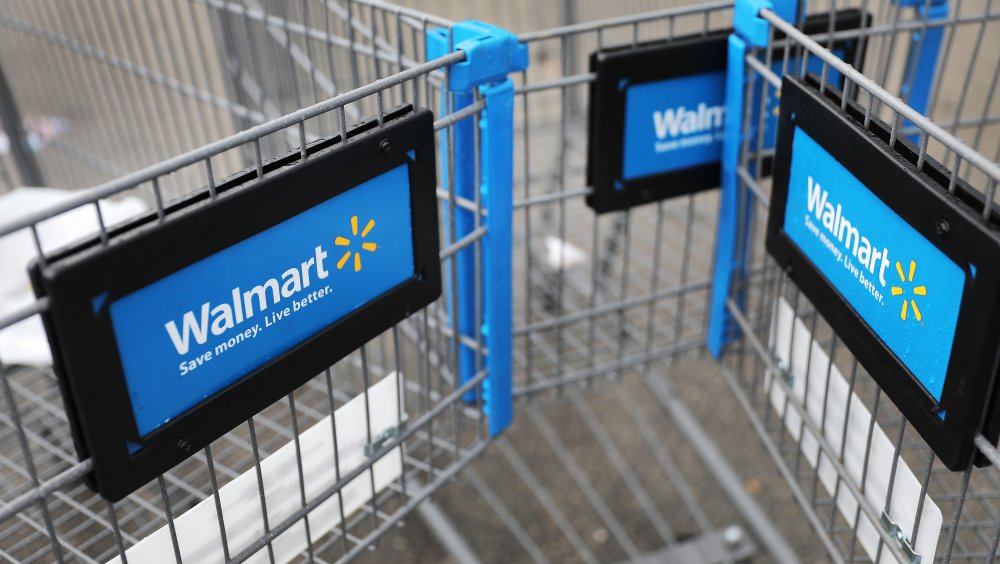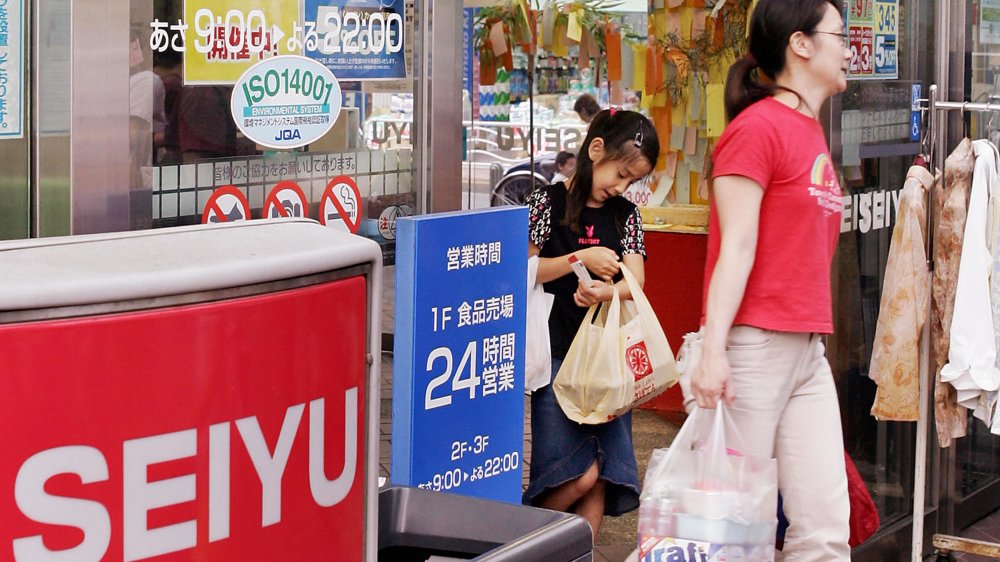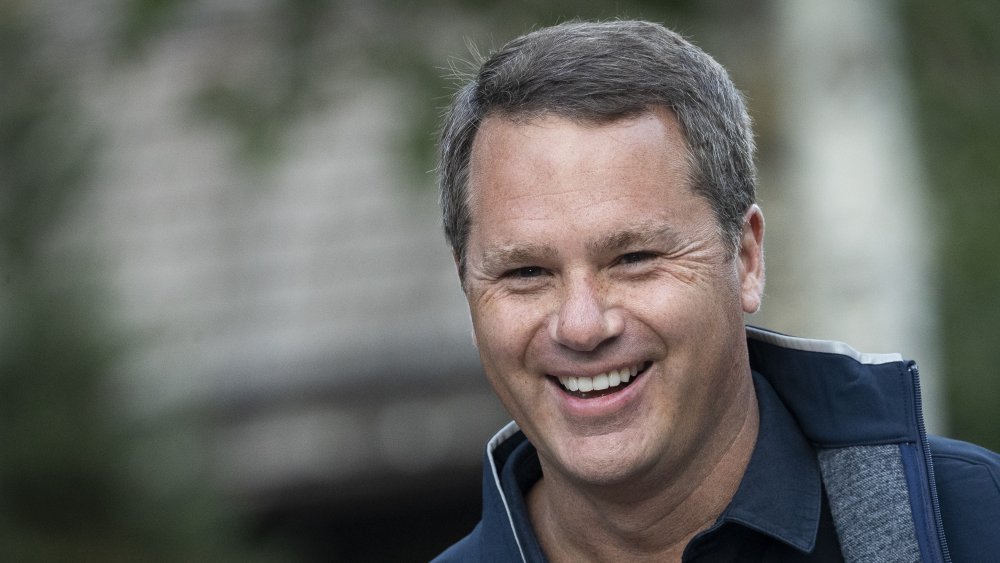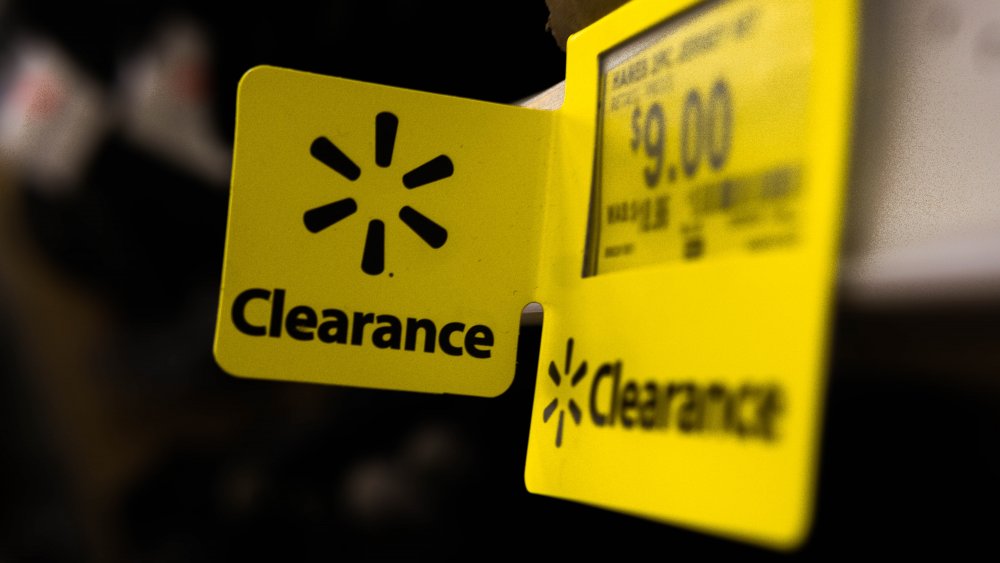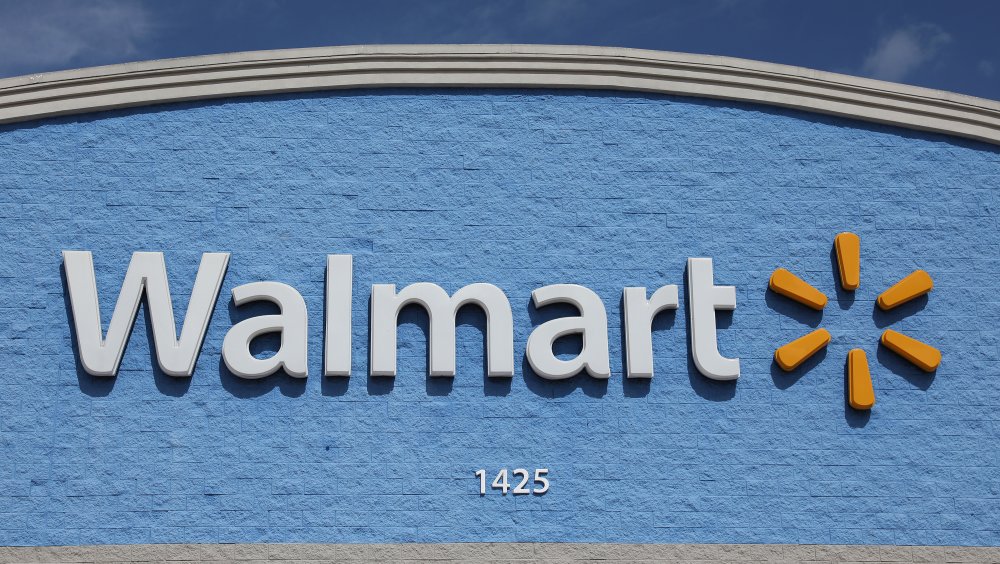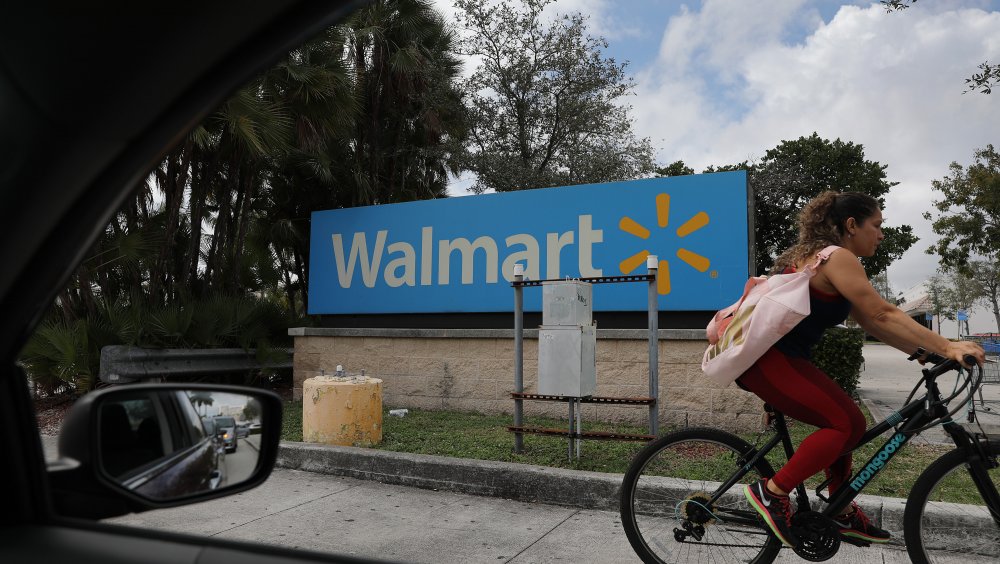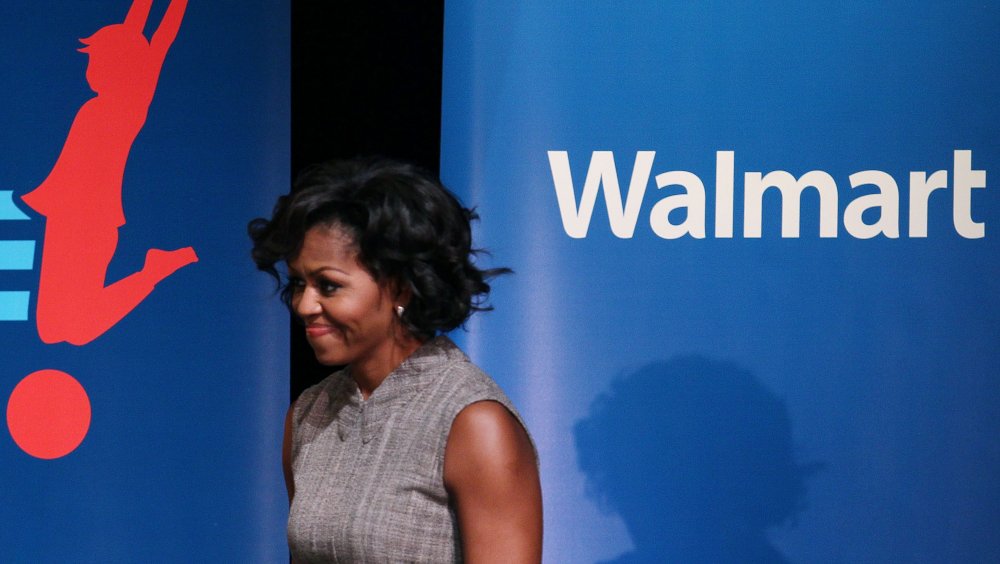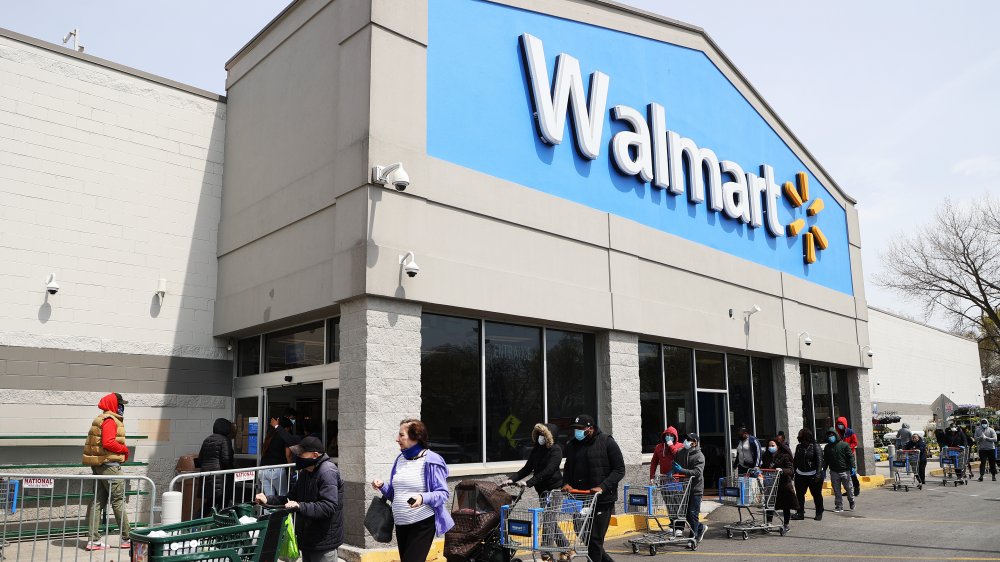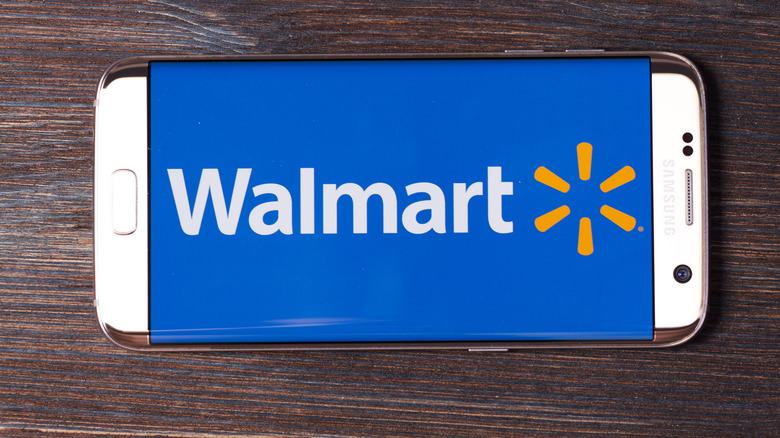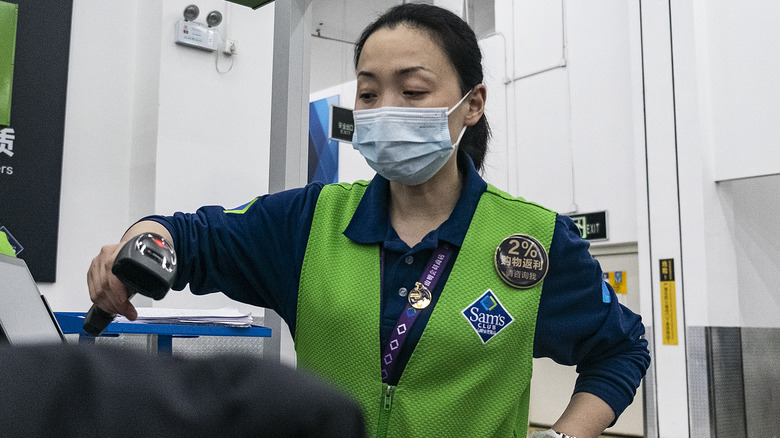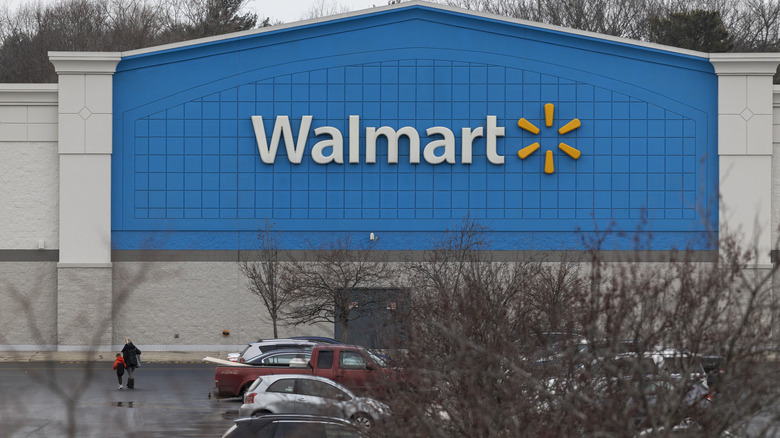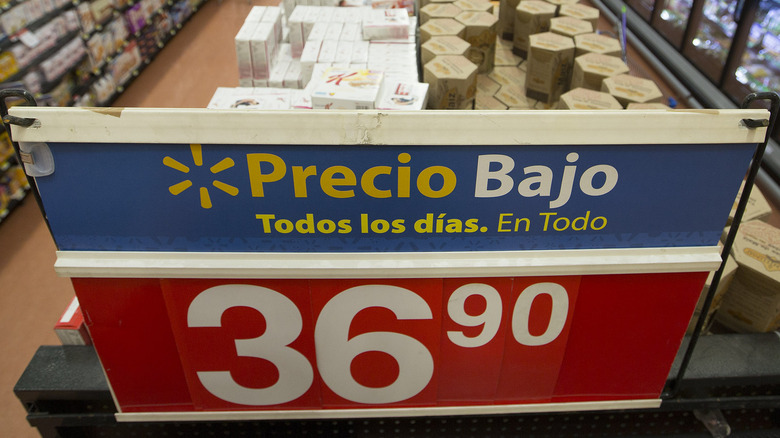The Untold Truth Of Walmart
We may receive a commission on purchases made from links.
You may feel as though you are pretty familiar with mega-retailer Walmart given its status as a household name and one of the most recognizable brands in the country, if not the world. Chances are that since it's viewed by many as a polarizing company, you either have a very positive view of it — or a very negative one.
Given the fact that most people in the United States make at least one trip to a Walmart store annually (via Quartz), and the company employs a whopping 1.5 million Americans (via Walmart), it stands to reason that most consumers are at least vaguely familiar with the brand. However, since the company's early days as a small-scale retailer, there are plenty of twists and turns in the Arkansas-based chain's storied history, as well as more than a few oddball facts that you might not realize from your (at least) once-a-year shopping trip.
This is the untold truth of the American giant, Walmart.
Walmart's founder started with a five-and-dime store in Bentonville, Arkansas
Sam Walton, Walmart's founder, was worth more than $8.6 billion when he died in 1992 (via Celebrity Net Worth), but like many American tycoons he started small. After graduating from college, he worked for 18 months with J.C. Penny to become familiar with the retail industry, and in his early years in the business he franchised a number of Ben Franklin general stores (via Encyclopedia Britannica).
In 1962, he opened his first retail location that bore his name. It wasn't in the cavernous warehouse-type building where Walmart super centers are housed today. Instead, Walton's five-and-dime was a modestly-sized general store on the town square in Bentonville, Arkansas with a 1950s-style red and white facade and awning that has been retained to this day. Today it houses the Walmart Museum, where Walmart souvenirs and trade show-like displays which recount the history of the company are housed. One artifact on display at the museum is the official Walmart articles of incorporation — the paperwork which legally records the creation of a business (via Business Insider).
Walmart failed badly in South Korea and Germany
While much of its history has been marked by profits and business successes, Walmart has also seen plenty of missteps. In 2006, the company had its fair share of struggles, and made the decision to pull out of both the German and Korean market.
Germany was Walmart's first attempt to enter the European market and it did not go over well (via The New York Times). The stores were often located on the outskirts of town and not easily accessible for those without a car. Before deciding to pull out of the German market, the company decided to stop requiring its sales associates to smile at customers as some male shoppers interpreted it as flirting. "Germans just don't behave that way," said the secretary of a labor union which represented the company's employees. Although they had lost hundreds of millions of dollars since 1998 as a result of their expansion into Germany, a company spokeswoman called it a "good, important lesson."
In South Korea, where the company operated just over a dozen stores, they decided to sell out to their local competitor, and get out of the Korean market as well (via The Wall Street Journal). With only one store in the capital Seoul, Walmart was unable to acquire the same name-brand recognition they enjoy in the United States and couldn't compete with established Korean brands.
Walmart has different names in different countries
Walmart operates some 4,600 stores outside of the United States (as well as about the same number of stores domestically) and uses 60 different store names for their international locations, according to Biz Fluent. While they have every right to change the names of the stores they acquire (or sometimes partner with), often, they choose keep the names of the international brands so that local shoppers have a pre-existing name-brand association.
In Mexico, Walmart operates stores called Bodega Aurrera and Bodega Aurrera Express (via Knoji). Walmart entered the Mexican market in 1991 and has more stores there (over 1,600 locations) than any other country besides the United States.
In Brazil, another one of the company's oldest international markets with the first store opening there in 1995, the company has stores called Toda Dia, Maxxi Atacado, Nacional, BIG, and Mercadorama.
Japanese Walmart locations operate under the Seiyu brand, and in the United Kingdom the stores are known as Asda and Asda Supercentre.
Bananas are Walmart's best-selling item
While you can buy items as offbeat and wacky as Major League Baseball-themed urns or pickle-flavored ice pops at Walmart, most people shop at the store to stock up on home essentials at a cheap price. This helps to explain why out of the hundreds of thousands of products on sale at every store, the company's best selling product is bananas.
According to The Daily Meal, this has been the case for years. A billion pounds of the fruit are sold every year in its locations globally, which can be broken down to 32 pounds of bananas every second of every day of the year.
While this may seem like an insane number, author Dan Koeppel, who wrote an entire book about bananas, reports that Americans eat more bananas every year than oranges and apples put together. And a Walmart spokesperson pointed out that "customers love bananas because they're an easy, healthy food to back and eat and very affordable. Kids also love bananas, and so a lot of customers are probably thinking of their children" (via Business Insider).
Living in an area with Walmart can have an impact on your weight
Having a Walmart close by may help your wallet, but it won't help your waistline. A study carried out in 2010 by researchers at the University of North Carolina and Samford University found that opening "an additional [Walmart] store per 100,000 residents increased an area's average body mass index by 0.24 units, or 10.8 percent of the sample obesity rate" (via Science Direct). Their theory was that given the store's business model which entails selling cheap, bulk processed food, having a Walmart in your neighborhood can have a significant impact on your eating habits and by extension, your body mass.
The study went further to suggest that even though customers were saving money by shopping at Walmart, they eventually negated these savings with higher healthcare costs as a result of their obesity. According to the study: "These results imply that the proliferation of Walmart Supercenters explains 10.5 percent of the rise in obesity since the late 1980s, but the resulting increase in medical expenditures offsets only a small portion of the consumers' savings from shopping at Supercenters" (via SSRN).
Even if you don't have a Walmart in your general vicinity, the study pointed out that because other mega-stores such as Target and Sam's Club (a Walmart brand) follow a similar business model, your diet is likely still being impacted (via Organic Authority).
One violent crime is committed every day on average inside a US Walmart
Typically, we think of most retail locations as a generally safe environment. Walmart suffers from petty crime, of course, as most retailers do — typically hundreds of thousands of police reports are filed annually for petty crimes committed at Walmart (via Bloomberg). Petty crimes such as these include shoplifting, graffiti, and vandalism. However, there are much larger crimes going on at Walmart locations as well. The crimes committed range from attempted kidnappings and murders, to the operation of a meth lab inside a 6-foot drainage pipe in a parking lot outside the store. About one violent crime per year is committed every day on average at a Walmart. Some local police departments say that their deputies are unable to respond to all of the calls that come from Walmart because there are simply too many.
Though no one can pinpoint the exact source of the problem, it may have something to do with Walmart cutting staff in multiple departments. As a cost-cutting measure, greeters who worked at the front door but also served as loss-prevention team, were cut. Over time, cashiers were phased out and replaced with self-checkout systems. One new employee is hired for every 524 square feet of store space, which is a 19 percent increase from ten years prior. When criminals think that there aren't enough employees to catch them, they're more liable to commit crimes. In response to the epidemic, the company has said that they will install security cameras at their locations and retrain existing workers.
Walmart's CEO got his start working at Walmart in high school
The company's CEO, Doug McMillon, began working at Walmart unloading trucks during the summer of 1984 (via Business Insider). His summer job paid $6.50 per hour and he used the money to pay for college (via Business Insider). He reportedly chose Walmart because the pay was better than McDonald's.
He worked his way through the ranks of the company and became CEO in 2014. He earned more than $22 million in 2017, a far cry from the Walmart median wage of $19,177. Even so, McMillon helped push for the company's move to an $11 per hour minimum wage — nearly double the wage he started out at all those years ago.
Though the story sounds a bit like a fairy tale, McMillon's case isn't entirely out of the ordinary, as the company believes that more than 75 percent of its management teams in stores began working as hourly employees themselves. McMillon has also had a role in helping to improve the company's online presence as it tries to compete with Amazon in the digital age.
Walmart is the world's largest private employer
With 2.1 million employees, Walmart trails only the United States Department of Defense and the Chinese People's Liberation Army (3.2 million and 2.3 million, respectively) as the largest employer in the world, as per World Atlas.
Because first and second place are occupied by government/military jobs, Walmart ranks as the world's largest private employer. In the United States, it's the largest private employer in 21 of 50 states, most of which are in the Midwest and southeast, according to Visual Capitalist. Texas, for example, where Walmart is the state's largest private employer, was home to over 168,000 Walmart employees in 2019. In Florida, they employed over 107,000 during that same time period.
And those numbers are about to get even bigger. Just this March, the company announced it would be hiring another 150,000 U.S. employees to add to its ever-growing ranks (via LoveMoney) in both stores and distribution centers. The new positions were listed as temporary, but rumor has it that many could easily become permanent.
It took a while for a Walmart store to open in every state
Walmart actually opened locations in Mexico and Canada before it opened stores in all 50 U.S. states.
In 1990, the store expanded to Mexico, in 1994 they opened their doors in Canada, and in 1995, they opened in Vermont. Before 1990, with the exception of one Sam's Club — also owned by Walmart — the company had no presence in the Northeast or on the West Coast (via MoneyInc).
The lack of Walmart locations on the West Coast may be explained by the competition posed by mega-retailer Costco, which was founded in Seattle, Washington and has its headquarters in Issaquah, Washington (via Costco). While Walmart now has stores all up and down the West Coast, there are many consumers in California, Oregon, and Washington who are loyal to Costco and would never dream of stepping foot inside a Walmart.
Walmart's income rivals that of many countries on earth
Many people have talked about the income of Walmart being larger than that of other countries on earth, but it's often stated as more of a general conversation point rather than a truly technical discussion of economics. It turns out, that argument might actually hold some water.
A 2017 paper written by a student at Fayetteville State University (in Walmart's birth state of Arkansas, no less) examined this theory (via SSRN). His research found that comparing annual sales from Walmart as laid out in the company's annual report to the gross domestic product of countries across the world ranked by the International Monetary Fund, The World Bank, and the United Nations, that Walmart was ranked 24th in the world. Walmart beat out, among other countries, Greece, Pakistan, South Africa, Singapore, Israel, Hong Kong and Thailand, but was worth less than Turkey, Russia, Spain, Mexico, France, Brazil, Argentina, and Taiwan.
It's unclear how this paper will ever be used other than to settle bets among friends, but it's a great example of the power Walmart holds.
Walmart is moving toward a future using renewable energy
Though you might not expect it, Walmart has taken an interest in using solar power to run its stores. The reasoning behind this, according to the company, is that it "lowers our energy costs and is clearly good for the environment, but another benefit is that it keeps prices low for our customers" (via The Motley Fool). In 2015, it was the biggest corporate installer of solar power, but has since given up that title to its competitor Target, and fell well behind Ikea. In 2017 Target installed 56 megawatts of solar power at its stores compared to 5 at Walmart, according to PV Magazine.
However, in 2018 Walmart announced a plan to bring solar power to a total of 500 of its stores in 22 states and Puerto Rico. This would bring solar power to around 10 percent of its U.S. stores compared to 90 percent at Ikea and 20 percent at Target stores. The company aims to have renewable power in use at half of its locations by 2025.
Walmart has also announced that it plans to use power created from wind farms in the Midwest. The move to solar power hasn't been an entirely smooth, though. The company sued Tesla, which purchased a solar panel company, in 2019 for providing faulty solar panels which set fires on the roofs of at least seven Walmart stores from 2012 to 2018 (via The New York Times).
Walmart teamed up with First Lady Michelle Obama to promote healthy eating
In 2011, Walmart and the first lady Michelle Obama announced they would be teaming up to promote healthy eating (via ABC News). The company pledged to reduce the cost of healthy foods like fresh fruits and vegetables, which would make customers more likely to purchase healthy option. (via Walmart).
As part of the program the store developed seals for packaging which would make it easier for shoppers to identify over 1,300 healthy food choices. Walmart also pledged to reduce the amount of salt and sugar in its own food brands Great Value and Marketside.
"For years, the conventional wisdom said the healthy products simply didn't sell — that the demand wasn't there, that higher profits were found elsewhere, so it just wasn't worth the investment. Thanks to Walmart and so many other great American businesses, we are proving the conventional wisdom wrong," said Michelle Obama at an event celebrating the partnership in Springfield Missouri.
Walmart's charitable donations are around $1 billion annually
Most companies as profitable as Walmart engage in some sort of charitable giving. In 2005, after Hurricane Katrina struck and devastated large parts of the Gulf Coast, the company donated enough food for 100,000 meals (via The Daily Meal). They've stepped into help during similar disasters but also donate large amounts of money annually as part of their philanthropy program.
According to the president of the Walmart Foundation, the company's charitable giving arm, "Business exists to serve society... [and] philanthropy enables Walmart to go even further in addressing some of the world's toughest social and environmental challenges" (via Walmart). To that end, Walmart donates around $1 billion annually. Their charitable giving is concentrated to three main categories: creating economic opportunity, enhancing sustainability in supply chains, and strengthening community (via Walmart). Grant-making examples include $1.3 million given to enhance the livelihoods of lower-income farmers in Andhra Pradesh, India; $25 million given over five years to advance food safety in China; and $40 million given since 2011 to advance job training and education for veterans and military families.
The Walmart logo is a meaningful spark
For decades, according to IMC Hawks, Walmart was known as Wal-Mart, with a logo that rendered that dash as a star inside of an all-caps company name along with the slogan, "Always low prices. Always." In 2008, the retailer brought in corporate consultancy and design company Lippincott to execute a branding makeover. The result: Wal-Mart was now Walmart, and its credo became "Save money. Live better." The chain's visual branding elements changed, too, with the star gone in favor of six yellow-orange lines arranged in a circular pattern, creating a minimalist representation of a spark.
Each of those sections of the spark carries with it a meaning, corresponding to one of the company's stated core values. According to The Walmart Digital Museum, the center-top kernel stands for a commitment to customer service. Moving clockwise, the other bits connote, respectively, respect, integrity, its employee workforce (or "associates," in store parlance), and service. The final "half spark" is a nod to company founder Sam Walton's "original spark of inspiration and innovation."
Walmart uniforms got a makeover in 2019
Years after it rebranded its logo and signage, Walmart changed the collective appearance of its staff. In 2018, the company relaxed its associate dress code, allowing retail-level floor employees to wear clothing that they found more comfortable to work in, including jeans and athletic shoes. Those self-provided clothes were worn in addition to or underneath a store-issued blue or green vest bearing the Walmart name and logo.
That was status quo until 2019, when the company, reportedly ceding to associate request, redesigned the uniform vests. Walmart did away with the blue fabric in favor of a steel gray base with different colored trim (on the front and back) for different employee grades, which matches the Walmart spark logo on the side of the garment. Supercenter employee vests are steel with blue trim, while Neighborhood Market vests boast a green pop, for example. Additionally, the company reformulated the vests out of fabric composed of recycled plastic bottles. It also outfitted the uniform piece with larger pockets, which can more comfortably hold the equipment employees may need on the store floor.
Walmart rolled out the vests to its workforce in 2019, free of charge to employees. However, if an associate wanted to choose from a series of special customizable options and upgrades, it would cost them $11 per uniform alteration.
Walmart has owned many other businesses
Walmart is one of the biggest and wealthiest North American retailers, but its business empire stretches far beyond its titular brick-and-mortar super-variety stores, grocery-only outlets, and related collection of Sam's Club warehouse club-style stores. In 1999, per The Guardian, the company acquired European supermarket chain Asda for about $7 billion. After doubling its size from 225 locations to nearly 600, Walmart unloaded the division in 2021.
According to The Hollywood Reporter, Walmart sold more DVDs than anyone in the mid-2000s, and in 2010 moved into the burgeoning streaming and digital distribution spaces with the acquisition of Vudu, which was evolved into a competitor with subscription sites like Netflix and pay-to-rent services like iTunes. Home decor and art dealer Art.com, a company that sold $300 million worth of wall hangings a year, was acquired by Walmart in 2018 (per TechCrunch). That happened not long after the retailer dropped $51 million to acquire Moosejaw, a Michigan-based seller of outdoor and recreational gear with a handful of physical stores but a significant online presence, according to the Detroit Free Press. Walmart additionally controls or once controlled a few online clothing sellers, including ModCloth, Bonobos, and ELOQUII.
The biggest Walmart is in upstate New York
According to Walmart, the company's retail footprint is comprised mostly of three kinds of stores, all of them fairly sizable and well-staffed compared to other retail outlets. Standard variety stores take up an average of 106,000 square feet and employ 200 associates, while Supercenters sit on 182,000 square feet and have a staff of 300. Meanwhile, Neighborhood Markets occupy 38,000 square feet and require about 95 workers. All of those styles and stats seem relatively paltry compared to one outlier: the Walmart network's single largest individual retail outlet.
The biggest Walmart in the United States, according to Albany.com, dominates the Crossgates Commons in Albany, New York. It's built on the site of a closed Sam's Club. After that warehouse store shuttered in May 2006, Walmart took the space and merged it with the Walmart next door to form a super-Supercenter. At around 260,000 square feet, it's about the size of an average Supercenter and two Neighborhood Markets put together. The Crossgates Commons store is also the rare Walmart with escalators — one for people and one just for shopping carts — because there's a supermarket on the ground floor, and all the other merchandise on the second.
How to spot a final markdown price
Walmart carefully considers many factors when pricing its thousands of items. According to Entrepreneur, the chain eschews the usual retail psychological trick of a price ending in ".99," preferring instead to use slightly lower, fractional amounts, which makes customers subconsciously think that an item whose cost ends in ".88" or ".94" is absolutely as cheap as it can be, with those extra cents shaved off. But Walmart reserves certain price tag-ending numbers for special sales and closeouts.
According to a Walmart manager who spoke to The Krazy Coupon Lady (via Insider), the sign that an item has just its original price substantially slashed is if the cost ends in a "5," such as ".85" or ".95." After that, and only if Walmart is really looking to move out or close out a product as quickly as possible, it will apply a "final markdown price." Shoppers would be advised to grab those priced-to-move items before they're gone, which are the ones where the price ends in a rare "1" or "0."
You can buy wine for cheap at Walmart
Because it deals in such high volume — selling a fortune's worth of items everyday at each of its more than 10,000 stores — Walmart can negotiate lower wholesale costs from suppliers (per RetailDive) and then turn that around and sell those products to customers for much less than its smaller competitors might be able to afford. One thing Walmart can and does sell at rock-bottom prices is wine, traditionally regarded by many consumers as a luxury, high-cost item. What's more, that wine isn't all that bad, depending on who you ask. According to Epicurious, Walmart offers many well-reviewed, name-brand wines — red, white, dessert, and sparkling — for well under $15 a bottle.
All that doesn't even count its in-house wine line. In 2018, Walmart stores started carrying an array of wines with the Winemakers Selection label. That's the Walmart store brand, with Winemakers Selection basically being the fermented grape equivalent of the chain's Equate medical products, Ol' Roy dog food, and Great Value generics. Walmart relaunched the wine brand in 2020 with new varietals. Now, most selections don't cost more than $10, with some topping out at a mere five bucks.
A couple got married at a Walmart in Michigan
Merissa Anderson and David Medford met when they were both in the employ of a Walmart store in Guilford, Connecticut in 2013, according to MLive. There was soon a mutual romantic attraction but, looking to avoid the pitfalls of dating a coworker, Medford asked for a transfer to a department where he'd have less direct interaction with Anderson. Within a year's time, they were a couple, had moved in together, gotten engaged, and had both transferred to a Walmart in Saline, Michigan to be closer to Anderson's family.
Walmart is such a big part of the lives of Anderson and Medford, alone and together, that when they decided to get married, they planned on a September Sunday wedding in their Walmart's garden center. "It was one of those things we joked about a lot. We didn't know where we wanted to get married, and we didn't have a lot of money to do anything big," said Anderson. "Everybody we know works at Walmart, It's pretty much like our family now and all our friends are here."
Store manager Julie Trejo escorted Anderson down the aisle (of the garden department patio) while support manager William Anderson served as the officiant. The reception commenced in the employee break room, where guests dined on a three-tier chocolate cake prepared by the store's bakery.
